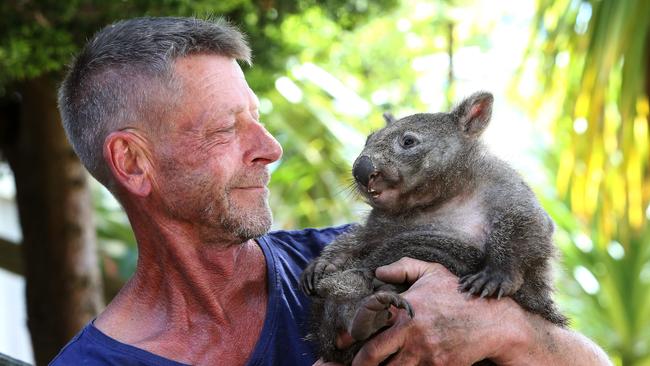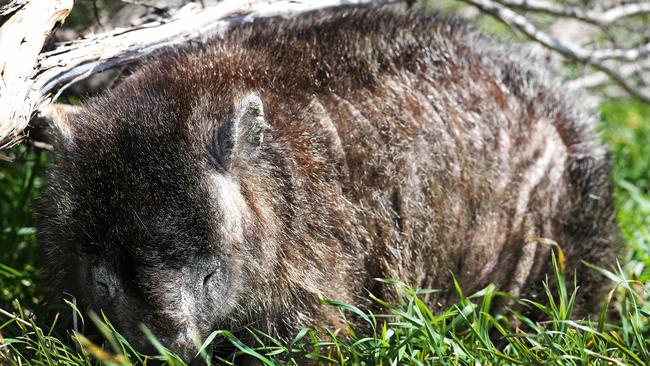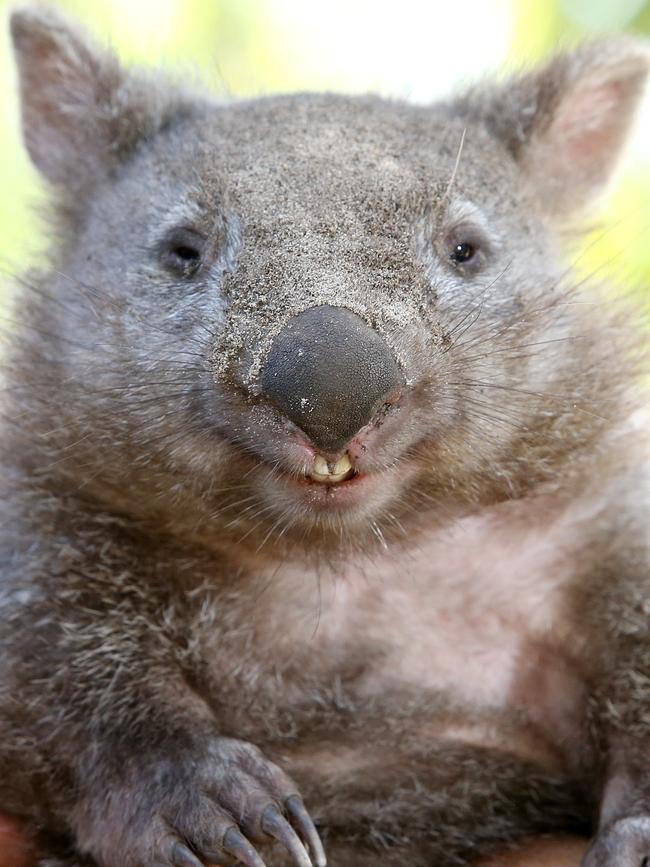The fight to save our wombats from devastating disease
A SHED in a quiet street is the hub of a citizen-led wildlife rescue mission as the wombat fights for its survival against a cruel killer.

Tasmania
Don't miss out on the headlines from Tasmania. Followed categories will be added to My News.
A SHED in a quiet street in the northern Tasmanian town of Kelso is the hub of a citizen-led wildlife rescue mission which could be replicated around the state as the wombat fights for its survival against a cruel killer.
Inside the shed, hundreds of burrow-flaps are being manufactured from steel, ice cream container lids and plastic bottle caps, as part of a volunteer-led crusade to save Tasmania’s wombats from decimation from the deadly disease sarcoptic mange.
The flaps are a simple but effective way of delivering a drench to treat the condition, a contagious infestation of the mange mite which, if left untreated, will cause a wombat to die a slow and agonising death.
The flaps are installed at the entrance to wombat burrows to drench the marsupials as their backs touch the plastic on their way in and out.
There are already signs that the treatment is working, as local infected wombats regain their sight, hearing and hair.
A band of 55 volunteers is involved in helping the wombats which call Kelso home.
At nearby Narawntapu National Park the population is in crisis, with researchers from the University of Tasmania estimating 95 per cent have already succumbed to mange and died.
So far, 130 flaps have been installed at burrow entrances around the state and a donation this week of $2000 to the group will allow volunteers to make another 500.

The Mercury spotted a big wombat in a paddock just outside Kelso on Thursday.
It was losing its hair and looked in very poor condition.
The marsupial also appeared to be blind and deaf.
Juvenile wombat Xavier is in a much better position.
He is living in a specially fenced-off enclosure in Stephen Jones’ backyard after being found alone on Greens Beach Rd.
He had contracted the mange and it is presumed his mother had died from the disease. Now his hair is growing back and he is putting on weight as he is formula-fed.
“You can see from looking at the local wombats the drenching is working,” Mr Jones said.
“We will release him eventually and just hope he doesn’t catch the disease again.”
Research conducted by the University of Tasmania shows the disease is sweeping through wombat populations and there are fears it could face a situation as dire as that confronted by the Tasmanian devil.
MORE: WOMBAT WIPEOUT FEARS GROW

UTAS researcher Scott Carver will meet Kelso’s “wombat army” at Narawntapu National Park later this month to discuss the wildlife crisis. Volunteer John Harris said people from other parts of the state were asking how they could help their local wombats.
“The community spirit seen at Kelso is probably alive in every area of Tasmania – people just need to know what to do and how to do it,” Mr Harris said.
“No one knows the answers but it appears we have come across a working solution that anyone can do with the right information and training.
“This is a simple step to take and we see every wombat treated as a real achievement.”
He said the rescue mission could be the first in Tasmania’s history in which residents were taking an active part in the protection of a native species.
“They are our wombats, our responsibility and sitting around waiting for the government to do anything is not an option,” he said.
“We have a plan to expand statewide but we need to ensure that everything that gets done meets all desired legal requirements.”
MORE: CURE FOR DISEASE THREATENING WOMBATS NEEDS MONEY
He said the volunteers were bringing their own sets of skills to bolster the rescue effort. Some are filling out paperwork, or organising and promoting meetings. Beatrice Mayne is making the burrow flaps, local agricultural supply businesses are chipping in, Kelso caravan parks are on board and farmers are allowing volunteers onto their land to treat wombats.
Three nearby golf courses and more than 800 hectares of land is now being monitored for sick wombats.

The mange crisis is not limited to northern Tasmania, however, with infected wombats being found on Flinders Island, along Tasmania’s East Coast, in Burnie’s hinterland and in the Cradle Mountain-Lake St Clair National Park.
Rosevears MLC Kerry Finch has called for government funding to help the volunteers with their rescue mission and for wildlife agencies to act fast before the wombat is beyond saving.
The Department of Primary Industries, Parks, Water and Environment this week said it had been liaising with UTAS over the work it is doing at Narawntapu National Park.
Data has been provided to the department so it can explore what may be causing the decline of wombats there.
“At this stage further work is needed to gain more information as to whether sarcoptic mange is the only contributing factor to the decline or whether there are other causes contributing that would need to be considered in identifying management responses,” the spokesman said.
“Sarcoptic mange has been present in wombat populations at Narawntapu National Park and many other areas around the state for many years prior to the population decline.”
The department said spotlight survey data had not shown wombat populations were declining in other areas of the state at this stage – including other areas where the disease was present.
“However, we are liaising with UTAS to identify if the work it is undertaking at Narawntapu can provide more detailed understanding of statewide population trends,” the spokesman said.
Mr Harris said signs would soon be erected asking motorists to report sick wombats so burrows could be found and fitted with the flap.
Anyone with ice-cream lids to donate can drop them off at the Beaconsfield feed shed or cafe. It takes about six weeks for a treated wombat to show signs of improvement – and not getting worse is a good sign in itself.
Wombats with mange become very thirsty so they are likely to be close to a water source.


